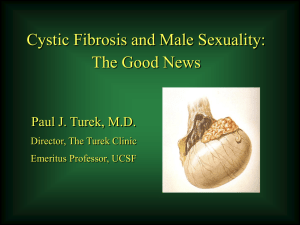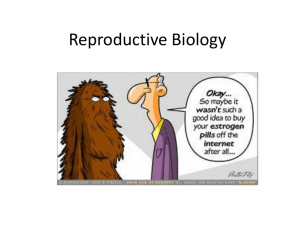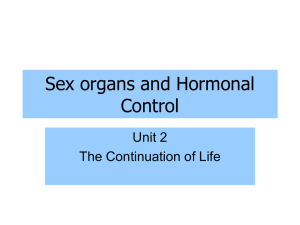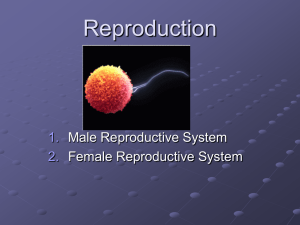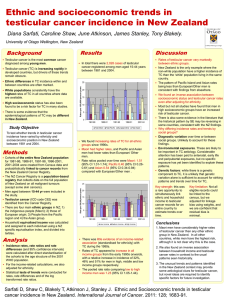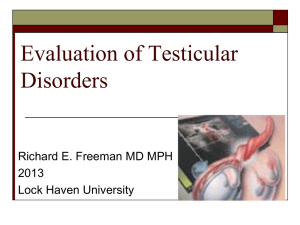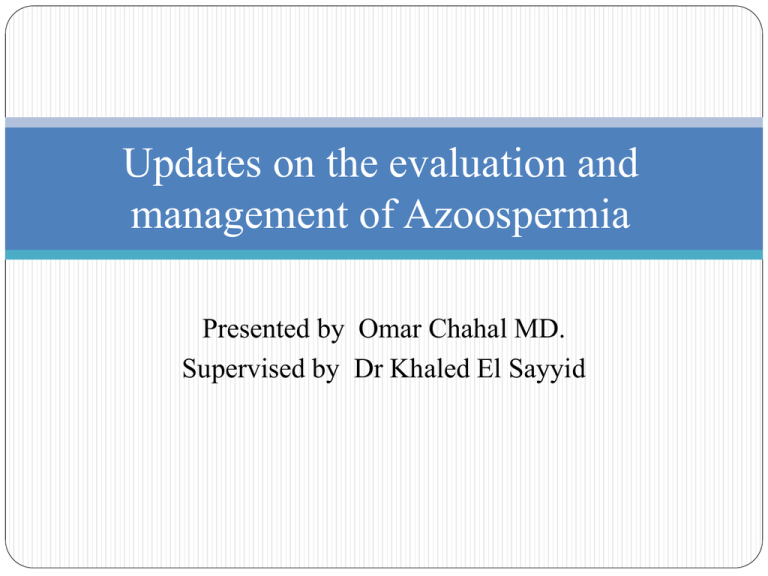
Updates on the evaluation and
management of Azoospermia
Presented by Omar Chahal MD.
Supervised by Dr Khaled El Sayyid
Definition of Infertility
Inability to conceive after 1 year of unprotected sexual
intercourse
Affects approximately 15% of couples
40% of cases involve a male
40% of cases involve a female
20 % involve both sexes
The Hypothalamic Pituitary Gonadal Axis
FSH & LH
In the testis, LH stimulates steroidogenesis within
Leydig cells by inducing the mitochondrial conversion
of cholesterol to pregnenolone and testosterone
FSH
binds to sertoli cells and spermatogonial
membranes within the testis and is the major stimulator
of seminiferous tubule growth during development & is
essential for the initiation of spermatogenesis at puberty
Semen analysis
Source
Volume
Characteristics
Urethral & bulbourethral
gland
0.1-0.2 cc
Viscous, clear
Testis, epididymis & vas
deferentia
0.1-0.2 cc
Sperm present
prostate
0.5-1.0 cc
Acidic watery
Seminal vesicles
1.0-3.0 cc
Gelatinous-fructose
positive
Complete ejaculate
2.0-5.0 cc
Liquefies in 20-25 min
Normal Sperm parameter
Abnormalities
Parameters
Normal values
Volume
>2.0 ml
*<2(oligospermia): partial retrograde ejaculation
short sexual abstinence duration
*>4: prolonged sexual abstinence
PH
7.2-7.8
*Acidic(6.5-7): Ejaculatory duct obstruction
*Acidic with low volume & non coagulation: CBAVD
Color
Whitish-gray
Pearl-white
*Yellowish: jaundice, carotenemia, drugs
*Reddish: hematospermia (secondary to urethral
bleeding or inflammation of the seminal
vesicles or genitourinary tumors)
Motility
>50%
Low: if sexual abstinence >5 days
Concentration
>20 000 000/ml
Polyspermia: associated with poor sperm quality
Morphology
>30% with Normal
morphology
Normal sperm possess an oval head with well-defined
acrosomal region composing 40% to 70% of the head area
AZOOSPERMIA
Azoospermia is defined as complete absence of sperm
from the ejaculate for at least two separate centrifuged
semen samples
It is present in about 1% of all men and in approximately
15% of infertile men
Azoospermia is different from aspermia, in that aspermia
is the complete absence of seminal fluid emission upon
ejaculation
Causes of Azoospermia
1)Pretesticular: also called secondary testicular failure,
usually endocrine in nature
2)Testicular: boardly termed as primary testicular failure,
these are intrinsic disorders of spermatogenesis
3)Posttesticular: includes Ejaculatory dysfunction or
obstruction of the genital tract, it constitute 40% of
cases of azoospermia
Pretesticular and post-testicular causes are often amenable
to treatment, which may restore fertility, whereas the
success rates for intervention in testicular pathology are
much more modest
Pretesticular
Hypothalamic disease
* Gonadotropin deficiency (Kallmann syndrome)
* Isolated LH deficiency
* Isolated FSH deficiency
* Congenital hypogonadotropic syndromes
Pituitary disease
* Pituitary insufficiency (tumors, infiltrative
processes, operation, radiation, deposits)
* Hyperprolactinemia
* Exogenous hormones (estrogen-androgen
excess, glucocorticoid excess,
hyper and hypothyroidism)
*Growth hormone deficiency (prader-willi syndrome)
Endocrine profile in infertile men
Condition
Testosterone
FSH
LH
Prolactin
Primary testis failure
low
high
high
Nl
Hypogonadotropic hypogonadism
low
low
low
Nl
Hyperprolactinemia
low
low
low
high
Androgen resistance
high
high
high
Nl
Testicular
Chromosomal (Klinefelter syndrome [XXY], XX sex reversal,
XYY syndrome)
Noonan syndrome (male Turner syndrome)
Myotonic dystrophy
Vanishing testis syndrome (bilateral anorchia)
Sertoli-cell-only syndrome (germ cell aplasia)
Y chromosome microdeletions (DAZ gene)
Gonadotoxins (radiation, drugs)
Systemic disease (renal failure, liver failure, sickle cell anemia)
Defective androgen activity
Testis injury (orchitis, torsion, trauma)
Varicocele-induced testicular damage
Idiopathic
Posttesticular
1- Reproductive tract obstruction
a. Congenital blockages:
Congenital absence of the vas deferens (CAVD), example: Cystic Fibrosis
Young syndrome (triad of chronic sinusitis, bronchiectasis, and obstructive
azoospermia)
Idiopathic epididymal obstruction
PKD (secondary to obstructing cysts in the epididymis or seminal vesicle)
Ejaculatory duct obstruction
b. Acquired blockages:
Vasectomy (performed for contraception)
Groin surgery (iatrogenic injury of inguinal vas from hernia repair)
Infection (which may involve the epididymis, with scarring and Obstruction)
c. Functional blockages:
Sympathetic nerve injury or medications that impair the contractility of seminal
vesicle or Vasal musculature
Posttesticular
2- Disorders of sperm function or motility
a.
b.
c.
Immotile cilia syndromes (Men have nonmotile but viable sperm in
normal numbers)
Maturation defects (due to epididymal dysfunction after vasectomy
induced Blockage)
Immunollogic infertility (may result from an abnormal exposure to
sperm antigens after testicular injury)
Although both primary and secondary testicular failure will be
associated with marked reduction in testicular volume, these
entities can be distinguished by serum endocrine testing to
include FSH, LH, testosterone, and prolactin levels
High serum FSH levels, typically greater than two times
normal, are indicative of primary testicular failure, and
diagnostic testicular biopsy is not required to rule out
obstructive etiologies
Primary testicular failure in conjunction with azoospermia,
commonly termed nonobstructive azoospermia (NOA), is best
managed with testicular sperm harvest for eventual ICSI
Azoospermic patients with normal testicular size, palpable vas
deferens, and normal serum FSH levels require a diagnostic
testicular biopsy to differentiate genital tract obstruction from
disorders of spermatogenesis such as maturation arrest
Evaluation of specific conditions
associated with azoospermia
Ι. Absence of the vasa deferentia (vasal agenesis):
The most common cause of congenital bilateral absence of the vas
deferens (CBAVD)
is a mutation of the cystic fibrosis
transmembrane conductance regulator (CFTR) gene
About 95% of males with clinical cystic fibrosis have CBAVD, and
approximately 70% of men with CBAVD and no clinical evidence
of a cystic fibrosis have an identifiable abnormality of CFTR gene
The diagnosis of vasal agenesis, either bilateral or unilateral, is made
by physical examination
Imaging studies and surgical exploration are not necessary to
confirm the diagnosis, but may be useful for diagnosing
abnormalities associated with vasal agenesis
Due to the embryological association between the vasa and
seminal vesicles, most patients with vasal agenesis also
have seminal vesicle hypoplasia or agenesis. Since the
majority of semen is derived from the seminal vesicles,
almost all patients with CBAVD have low semen volume
In the azoospermic patient who has unilateral vasal
agenesis,
radiologic
imaging
with
transrectal
ultrasonography (TRUS) may be useful to evaluate the
ampullary portion of the contralateral vas deferens and the
seminal vesicles, because unilateral vasal agenesis can be
associated with contralateral segmental atresia of the vas
deferens or seminal vesicle, resulting in obstructive
azoospermia.
An abdominal ultrasound or CT scan should be obtained to
assess anomalies such as renal agenesis
In 1 study, 26% of men with unilateral CAVD and 11% with
CBAVD had Renal agenesis. This association between
unilateral vasal agenesis and ipsilateral renal anomalies is
due to their common embryological origin
However, since a man with CBAVD most likely has
mutations in the CFTR gene, the Guidelines recommend
genetic testing for CFTR mutations in the female partner
before using sperm of a man with CBAVD
Π. Ductal Obstruction:
a) Patients with normal ejaculate volume
The serum FSH of a patient with normal semen volume is a critical factor
in determining whether a diagnostic testicular biopsy is needed to
establish the presence or absence of normal spermatogenesis
In fact, FSH values in the upper normal range usually indicate impaired
spermatogenesis while marked elevation of serum FSH is diagnostic of
abnormal spermatogenesis – usually nonobstructive azoospermia
Although a diagnostic testicular biopsy will determine if spermatogenesis
is impaired, it does not provide accurate prognostic information as to
whether or not sperm will be found on future sperm retrieval attempts
for patients with nonobstructive azoospermia
In addition, in cases of nonobstructive azoospermia, the presence or
absence of sperm in a diagnostic testicular biopsy specimen does not
absolutely predict whether sperm are present elsewhere in that or the
opposite testis
Therefore, a testicular biopsy is not necessary to either
establish the diagnosis or to gain clinically useful prognostic
information for patients with clinical findings consistent with
the diagnosis of nonobstructive azoospermia (i.e. testicular
atrophy or markedly elevated FSH)
Conversely, patients who have a normal serum FSH should
undergo a diagnostic testicular biopsy
The recommendation of the Male Infertility of AUA
is to use the diagnostic testicular biopsy to
distinguish between obstructive and nonobstructive causes of Azoospermia in patients
with normal testicular size, at least 1 palpable vas
deferens and a normal serum FSH level
If the testicular biopsy is normal, obstruction at some level in
the reproductive system must be present and the location of
the obstruction may then be determined
Most men with obstructive azoospermia, palpable vasa and no
history suggesting iatrogenic vasal injury have bilateral
epididymal obstruction
Epididymal obstruction can be identified only by surgical
exploration
Testicular biopsy can be performed
by a standard open incision
technique or by percutaneous
methods
A routine open testicular biopsy,
performed under local anesthesia, is
the most common method
This should be performed through a
small scrotal incision without
delivering the testis outside the skin
or tunica vaginalis
This
minimizes
postoperative
scarring and therefore facilitates
subsequent scrotal reconstructive
surgery
Vasography may be utilized
to determine whether there is
an obstruction in the vas
deferens or ejaculatory ducts
The use of this technique is
highly selective and should
only be performed by
urologists with microsurgical
experience, who can proceed
with reconstruction in the
same setting, as obstruction
can develop at the site of
vasography
b) Patients with low ejaculate volume
Low ejaculate volume (< 1.0 ml) that is not caused by
hypogonadism or CBAVD can be caused by ejaculatory
dysfunction, but is most likely caused by ejaculatory duct
obstruction (EDO)
Ejaculatory dysfunction rarely, if ever, causes low ejaculate volume
with azoospermia, although it is a well-known cause of aspermia
or low ejaculate volume with oligospermia
Additional seminal parameters that can be helpful in determining
the presence of EDO are seminal pH and fructose, since the
seminal vesicle secretions are alkaline and contain fructose
However, the results of semen pH and fructose testing may be
misleading when these tests are not properly performed and,
therefore, many experts tend to give less weight to these
parameters over other clinical findings
Transrectal ultrasonography
(TRUS) is indicated for
the diagnosis of EDO in
men with low ejaculate
volume and palpable vasa
While vasography is an
alternative diagnostic test
for EDO, TRUS is
minimally invasive and
avoids the risk of vasal
injury associated with
vasography
grossly dilated left seminal vesicle
with wide intravesicular spaces
The finding of midline cysts, dilated ejaculatory ducts
and/or dilated seminal vesicles (greater than 1.5 cm in
anteroposterior diameter) on TRUS is suggestive, but not
diagnostic, of ejaculatory duct obstruction
Conversely, normal seminal vesicle size does not
completely rule out the possibility of obstruction
Therefore, seminal vesicle
aspiration
(SVA)
and
seminal vesiculography may
be performed under TRUS
guidance to make a more
definitive diagnosis of EDO
The presence of large
numbers of sperm in the
seminal vesicle of an
azoospermic
patient
is
highly suggestive of EDO
Recommendation :
Transrectal ultrasonography with or without seminal vesicle
aspiration and seminal vesiculography, should be considered as an
initial minimally invasive diagnostic choice to identify
ejaculatory duct obstruction in azoospermic men with low
ejaculate volume and bilateral palpable vasa
In patients with ejaculatory duct obstruction demonstrated by
TRUS, testis biopsy may be considered if needed to confirm
normal spermatogenesis
Vasography with or without testicular biopsy should be considered a
second line choice to identify the site of reproductive tract
obstruction in these patients, and should not be done unless
reconstructive surgery is undertaken at the same surgical
procedure
Surgical management
TURED is the standard treatment of ED obstruction
In a series of 46 men with low semen volume
azoospermia or severe oligospermia, Schroederprintzen et al used TURED to treat, 46% had
improvement in semen quality and 20% initiated a
pregnancy. A concern of this study is that 4% of
patients who had sperm in the preoperative
ejaculation specimen became azoospermic after
treatment
Futhermore, 20% of treated patients experienced
complications. Including watery, high volume
ejaculate, prolonged cathetherization for gross
hematuria, UTI, chronic epididymitis with recurrent
pain, post-void dribbling and premature ejaculation
Although the success rate is not impressive
and complications are not negligible,
TURED may allow select patients to
undergo assisted reproductive techniques
with ejaculated sperm
Given the potential complications of urinary
sphincter injury, rectal injury and reflux of
urine into the reproductive tract with the
use of TURED
An alternative treatment for ED obstruction
was proposed. In 1995 jarow and zagoria
published a report on the use of antergrade
balloon dilatation of the ED with the
patient under general anesthesia to
recanalize an obstructed ED
The authors preferred the antegrade approach
as it is often difficult to catheterize the
orifice of the ED transurethrally, especially
with distortion of the anatomy that may be
present with obstruction
Microsurgical reconstruction
of the reproductive tract
(vasovasostomy
&
vasoepididymostomy)
It is successful in patients with
obstructive azoospermia
Following vasectomy reversal, for
example, return of sperm to the
ejaculate occurs in 70-95% of
patients, and pregnancies are
obtained without the need for
assisted reproduction in 30-75%
of couples
A very important factor influencing the likelihood of sperm returning to
the semen and of pregnancy after vasectomy reversal is:
The number of years between vasectomy and attempted
reconstruction
The length of the obstructive interval
the presence or absence of sperm in the intraoperative vas fluid; the
gross appearance and quality of the sperm in the vas fluid
The length of the vas segment between the epididymis and the
vasectomy site
The presence or absence of a sperm granuloma at the vasectomy site
The likelihood of pregnancy after vasectomy reversal is also heavily
influenced by the age of the female partner
Intra Cytoplasmic Sperm
Injection:
The sperm requirement for egg
fertilization has dropped from
hundreds of thousands for IVF to 1
viable sperm for ICSI
This has led to the development of
aggressive new surgical techniques
to provide sperm for egg
fertilization from men with
apparent azoospermia
Clinical pregnancy rates reported in
the recent literature range from 2657% and delivery rates range from
18- 75%

